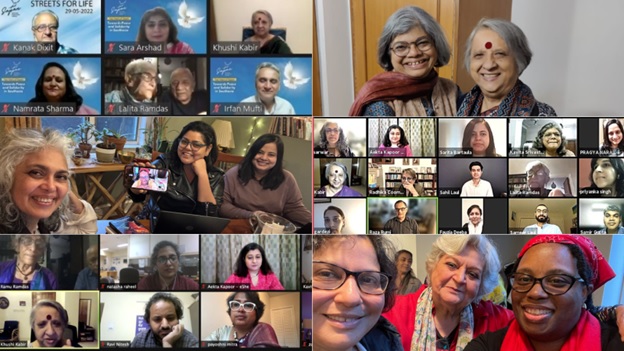
Some Sapan activists, speakers and volunteers at in-person and online events over the past year. Collage by Pragyan Srivastava. As Women’s History Month ends, a journalist from India shares her impressions about the primarily women-led Southasia Peace Action Network, or Sapan, that she has been volunteering for, now entering its fifth year. What is special about this volunteer-run, cross-border, cross-diaspora initiative that has taken on a formidable task?
Women at the Helm: The Driving Force behind Sapan’s Resilience

By Pragyan Srivastava
Boston, MA
It was October 2024, my first time volunteering with Southasia Peace Action Network, aka Sapan. I was assisting the technical team for a webinar hosted by Sapan. The discussion was a ‘country focus ’ on post-crisis Bangladesh — a topic both urgent and layered.
I had already met Beena Sarwar, one of Sapan’s founding members and a journalist from Pakistan, in the Boston area where we are both currently based. However, this online event was my first encounter with the other women behind Sapan. Over the coming months, I would learn how they have kept the movement running with quiet determination and remarkable efficiency since the initiative was launched four years ago.
As the dry run for the Bangladesh discussion began, I was impressed by the seamless coordination of the team. Sarita Bartula, a founding member of Sapan from Nepal, orchestrated the event with precision, ensuring that each segment flowed effortlessly. Fauzia Deeba, another founding member from Pakistan, was prepared with the slides for t he Sapan Founding Charter, which outlines the movement’s origins and aspirations.
Khushi Kabir, also a founding member and a human rights activist in Dhaka, shared her depth of knowledge by offering insights into the unfolding challenges in Bangladesh.
Meanwhile, feminist activists and Sapan founder members Khawar Mumtaz in Lahore, along with Lalita Ramdas in Alibag and Kavita Srivastava in Jaipur, worked tirelessly to promote the event. They leveraged their networks and expertise to amplify the conversation surrounding Sapan and its mission.
Watching them in action was an education in leadership — not the kind that seeks the spotlight, but the kind that sustains movements. Behind every Sapan event and campaign I saw over the next few months, women whose resilience and commitment made the impossible seem routine.
On 28 March, Sapan turned four — a milestone that is both a celebration and a moment of reflection.
Some of the faces on the screen at that meeting — small squares of light flickering across Delhi, Lahore, Dhaka, Kathmandu, Colombo, and beyond – were familiar to each other. Others were meeting for the first time. Some voices spoke with urgency, others with curiosity, or were cautious observers, but a shared belief bound them: Something had to change.
That was on the last Sunday of March, 2021, morning for some, and evening for others. The world was still grappling with isolation due to the worldwide pandemic, and for South Asians, borders — already hardened by politics and history — felt even more impenetrable. But everyone in that initial Zoom call united with one thought: “India-Pakistan dialogue must continue” for the sake of the people of the region.
It was not a political demand nor a diplomatic resolution but a simple conviction that led to the launch of the Southasia Peace Action Network , or Sapan, at the end of the meeting. This is a movement that refuses to be defined by divisions.
“Sapan is not affiliated with any government, political party, or agenda,” to quote longtime peace activist Irfan Mufti, a Sapan founder and an advisory council member in Lahore.
Initiated by journalists, artists, academics, activists, students, retired military personnel, and professionals from across the region and diaspora, Sapan champions peace, dialogue, and solidarity in a region that desperately needs it.
Lawyer Vishal Sharma, a long-time volunteer at Sapan and a PhD candidate in the UK, says in a video of Sapan’s 4th-anniversary celebration, “At Sapan, we do not promote foreign policies of any nation or agendas of think tanks; we offer a safe space for South Asians and the diaspora to connect.”
Over the past four years, Sapan has evolved into a bridge linking individuals from various sectors across India, Pakistan, Bangladesh, Nepal, Sri Lanka, Afghanistan, Bhutan, and the diaspora.
Through over 30 online seminars, advocacy initiatives, on-ground events, and the Sapan News platform, the initiative has tackled climate change, refugee rights, press freedom, and public health crises.
“Sapan resists the institutional logic that confines community,” reflects Sher Ali Khan on a phone call with me, an academic, community organizer and journalist from Lahore based in Massachusetts, who joined Sapan as a volunteer a few months ago. “It is a people-led counter-network, interrogating the power structures that constrain South Asians within the narrow confines of geopolitics.”
Sapan women
Beneath these achievements lies a deeper, often unspoken truth: women have been the backbone of Sapan’s resilience.
“Sapan is what it is today because of the incredible women who nurture and sustain it,” Sapan News Coordinating Editor Regina Johnson, who also volunteers at Sapan, working from her home in Virginia, shared during a call.
The same holds true for grassroots efforts beyond Sapan. Across South Asia, women have been at the forefront of peacebuilding, often in ways that go unnoticed. Whether it’s Afghan women fighting for their right to education, Pakistani and Indian activists resisting militarization, or Bangladeshi feminists advocating for marginalized communities, their work is often met with hostility — or worse, indifference.
Yet, they persist.
At Sapan, their persistence translates into action: Planning events, drafting statements, mobilizing networks, and creating platforms for unheard voices. They push forward not for recognition but because they understand that movements do not survive without consistent, committed labor.
As Sapan enters its fifth year, it carries forward a vision of:
- Freedom of Movement – A South Asia where people can travel, trade, and meet without restrictive visa policies.
- Human Rights for All – A commitment to protecting the dignity of minorities, women, children, and marginalized communities.
- Collaboration Over Isolation – A recognition that climate change, water crises, legal reform, and cultural preservation demand regional cooperation.
“We are not just dreamers; we are doers, shaping a future without barriers,” in a video message, exclaims entrepreneur and businessman Samir Gupta, a Sapan founding member in the greater Delhi area.
These efforts are not just about high-level discussions; they are about real, tangible acts of defiance against division. Sapan’s journey is far from over. But if the last four years have proven anything, it is this: Solidarity can survive despite borders, dialogue can persist despite political tensions, and movements can thrive even in uncertain times.
Because, as prominent feminist activist Khawar Mumtaz reminds us, peace is not a fantasy but a commitment.
(Pragyan Srivastava is a journalist from India working with Sapan News as an associate editor. A Fulbright-Nehru 2022 Master’s scholar at Rutgers University, she has extensive experience in digital storytelling, social media, and television production. She is passionate about creating authentic and powerful stories about South Asia. Email: pragyan@sapannews.com
This is a Sapan News syndicated feature.)

